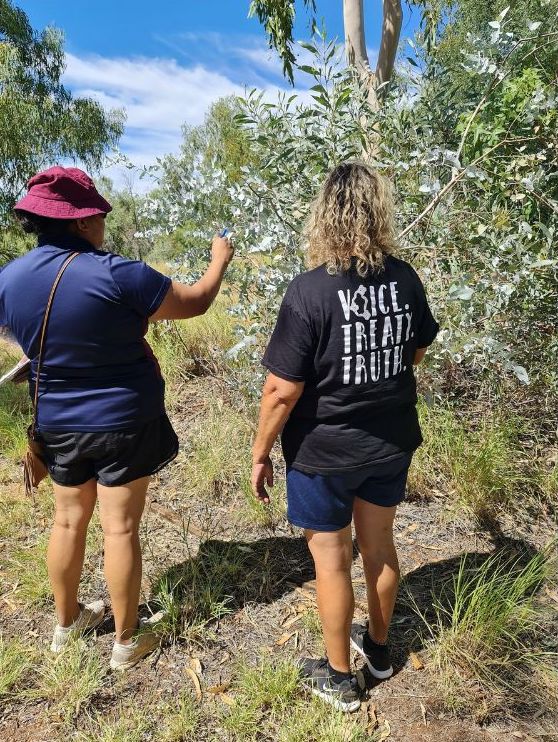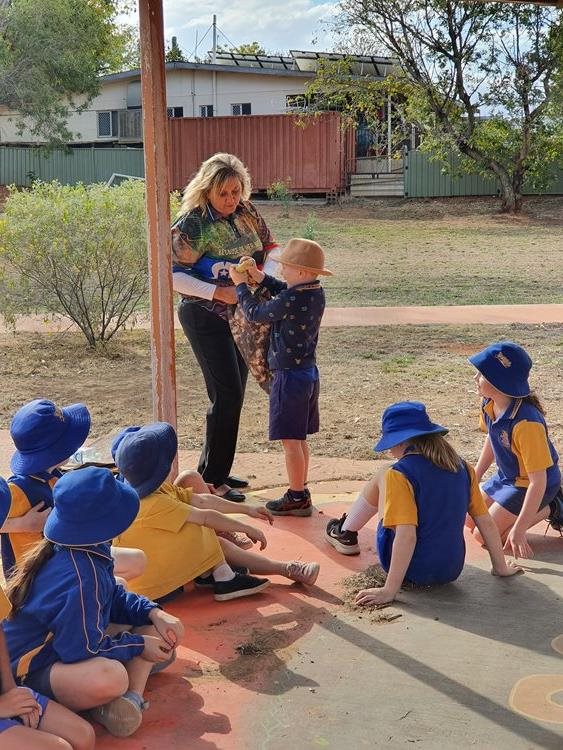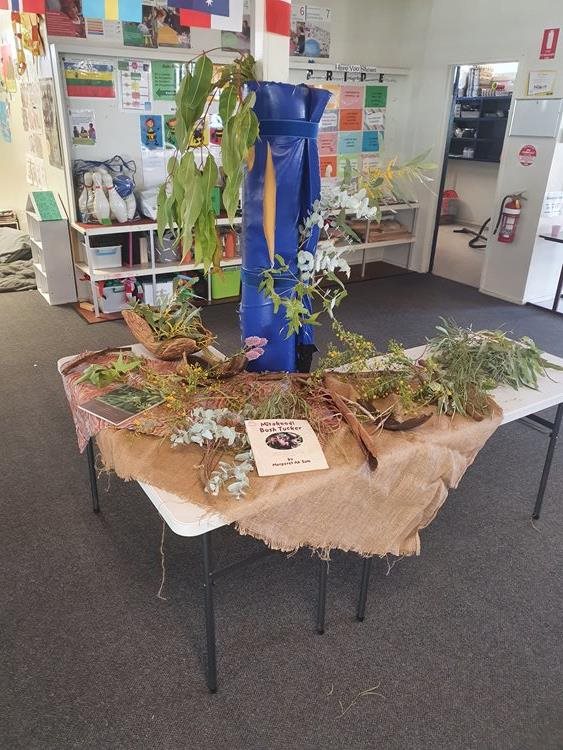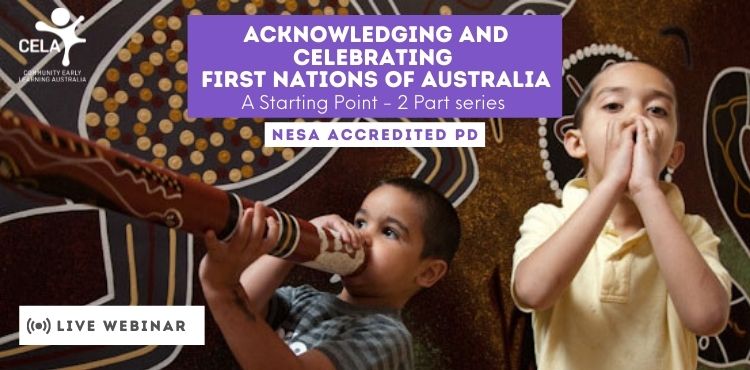During a cultural day at our OSHC centre, the coordinator and educators realised they were unsure how to respectfully implement and engage children in activities relating to Aboriginal and Torres Strait Islander culture. We wanted to ensure we weren’t being tokenistic and knew that we needed to build our knowledge around Indigenous cultures in our local area.
The coordinator at the time spoke to the inclusion support officer and was advised to write a project plan to submit for funding through the Innovative Solutions Funding Grants. We were also advised to make contact with Ros Von Senden (Aunty Ros), who is a member of the Kalkadoon people of Mount Isa, to see how she could help with our project.
The proposed project was planned to run over 12 months as we perceived this to be a reasonable length of time to build capacity and support all educators within the OSHC environment. The project framework incorporated professional conversations, real-time mentoring and coaching support, as well as strategies to help us develop cultural inclusion and community partnerships in our region.
The language and approach utilised were strengths-based — we aimed to include cultural and sustainable practices into our educational program using participatory leadership methods of modelling practice as well as implementing yarning and storytelling methods.
Making a start with a walk on Country
Throughout this project, staff collaborated with Aunty Ros to build their knowledge of local Aboriginal culture. This began with a walk on Country undertaken by coordinator Rachel Foulstone, assistant coordinator Elizabeth (Libby) Akee and Aunty Ros at the beginning of 2020. The walk was a great way to start the project as it allowed staff to identify local bush tucker and the uses of native plants around the school.
_____________________________
A walk on Country: A reflection by Rachel Foulstone
On Friday the 19th of March, we went on a walk with Aunty Ros Von Senden, a member of the Kalkadoon people of Mount Isa. This walk on country was a way for us to start our year-long relationship with Aunty Ros. She will join us each month to help us better understand incorporating Aboriginal culture, specifically Kalkadoon culture, within our program and everyday practice.
We met at Tharrapatha Way. Tharrapatha is the name for the Leichhardt River in Kalkadoon language. The Leichhardt River runs through the middle of Kalkadoon country and was the primary water source for the Kalkadoon people.
Aunty Ros took us on the path showing us the community garden, which had bush tomatoes, a soap bush, and other native plants. As we walked, she explained the different types of gum trees and their medicinal purposes, and pointed out the coolabah trees that are used to make didgeridoos. As we were looking at the wild orange trees, Aunty Ros found some quartz and demonstrated how the Kalkadoon people used quartz to make their spear tips.

As we were walking along the track and looking out at the Leichhardt River, Aunty Ros shared the different ways the Kalkadoon people used gum nuts, leaves and other things for jewellery. She explained the different types of ochre and how they created their paint and paint brushes. We discovered that when it came to art, the Kalkadoon people didn’t create dot paintings, but instead focused on painting representations of what they saw, occasionally mixing animal blood into the ochre so that it would seep into the paint and last longer.
After our walk, Libby and I talked about what we got out of the Walk on Country. We both learnt many things and felt a connection to the land that we hadn’t felt before. We both have a newfound respect for the Kalkadoon people and their traditions and are looking forward to the wealth of knowledge that Aunty Ros will bring to the service and the children.
_____________________________
Shortly after our walk on Country, Aunty Ros brought in some examples of native plants found along the creek and books that helped staff and children easily identify the different types of plants. The children learnt how to use native plants for medicine and how to identify the different types of gum trees around our town. They enjoyed showing their parents what they had made with Aunty Ros as they were being collected.

Respect for ourselves, respect for each other and respect for the land
One of the primary outcomes was the knowledge we gained from local Kalkadoon stories we were told during group times with Aunty Ros. She taught the staff and the children about the importance of respect.
With assistance from Aunty Ros, we were able to identify chalk rocks within our courtyard space, and we learnt how to create ochre by crushing them and adding water. The children enjoyed discovering the different colours that could be made from the rocks. Throughout the project, we learnt how to use other natural mediums and objects to create art.
The children spent one afternoon identifying native Australian animals and producing their own version of the animals using ochre-coloured paints on calico. This activity helped the children to understand which animals are native to Australia and what their natural colours are.
In a later visit, Aunty Ros read a book about respect. We were able to extend on the learning that resulted from this reading by creating a poster with the children that showcased their ideas of what respect means.
During reconciliation week this year, we focused on what the children’s interests were and added a cultural aspect to that activity, which in this case was sand art. Children drew Aboriginal symbols with glue and pressed them into sand to create art on Indigenous themed paper. This showed respect for local environments and diversity while also being culturally aware.
A deeper understanding of how to build a culturally respectful program
Throughout the project, staff gained a better understanding of how to implement and engage children in a program that is respectful of local Aboriginal and Torres Strait Islander culture. We identified similarities and differences between the two cultures and learnt how to have meaningful conversations with the children about cultural inclusion.
Aunty Ros helped us identify our cultural beliefs and how they can shape our relationships with children.
As a service, we aim to avoid being tokenistic about what we are programming for children because we learnt that to be culturally aware, we must first understand the culture in a way that is specific to the land we are on. We are still looking for ways to embed culture within our service, but with the knowledge we gained from Aunty Ros, we are better informed about how to incorporate these activities into our weekly program.

Libby:
Being a Torres Strait Islander woman myself, Aunty Ros helped me further identify with my own culture. This sparked my interest in where I come from and helped me reconnect with my family. I have conversations with my dad now that give me more understanding of who I am and how my totems shape me. Working alongside Aunty Ros has helped build my cultural competence, and I feel that I have taken in much of what she taught me. The wonders of the country we live in and how we can benefit from our lands.
Rachel:
The program with Aunty Ros has helped me become more confident in speaking about Aboriginal culture with the children at the service. It has also benefitted me greatly to realise that we can include Aboriginal culture in almost every aspect of our day, to really embed Aboriginal perspective within our service culture. I learnt a great deal about the Kalkadoon people during our time with Aunty Ros helping me have a newfound respect for our local First Nations People
_____________________________
How to start embedding Aboriginal and Torres Strait Islander perspectives into your program
In this article titled Embedding Aboriginal and Torres Strait Islander perspectives through program and practice, Jessica Staines, Director of the Koori Curriculum, explores National Quality Standard 1.2 and shares ideas on how educators can embed Aboriginal and Torres Strait Islander perspectives through their program and practice.
Jessica notes that it’s important to know the ‘why’ around embedding these perspectives and that while it can be a daunting process, the best place to start is where you feel comfortable. This could be listening to Indigenous music, cooking bush tucker or exploring Indigenous art.
Jessica says:
“The Koori Curriculum has general principles that we utilise when supporting educators to embed Aboriginal and Torres Strait Islander perspectives in their program, which are:
-
Including a balance of contemporary, traditional, urban, regional and local cultural perspectives.
-
Holistically programming and planning to embed an Aboriginal and Torres Strait Islander perspective in context to children’s interests.
-
Ensuring culture is play based and not themed based teaching – this means Aboriginal, and Torres Strait Islander people are not the topic, theme or interest. Additionally, when Aboriginal and Torres Strait Islander resources, tools and artefacts are available at a service, ensure they are utilised in play and not used in cultural corners as a display.
-
Sprinkling culture across multiple play spaces instead of creating cultural corners.
-
Celebrating culture with all age groups and not only in the pre-school room.
-
Including Aboriginal and Torres Strait Islander perspectives every day and not only on significant dates or during cultural celebration periods."
Further reading:
Jessica Staines. Embedding Aboriginal Perspectives, NSW Department of Education
CELA writers. Tyabb Village’s real life RAP journey – 2 years on. CELA, Amplify!
Deborah Hoger (August 2021). How you can conduct a bookshelf audit. CELA, Amplify!
Deborah Hoger (June 2020). Avoiding the trap of cultural tokenism. CELA, Amplify!
Deborah Hoger (November 2020). Demonstrating respect for Country. CELA, Amplify!
Upcoming CELA professional development relating to this topic:

FIND OUT MORE